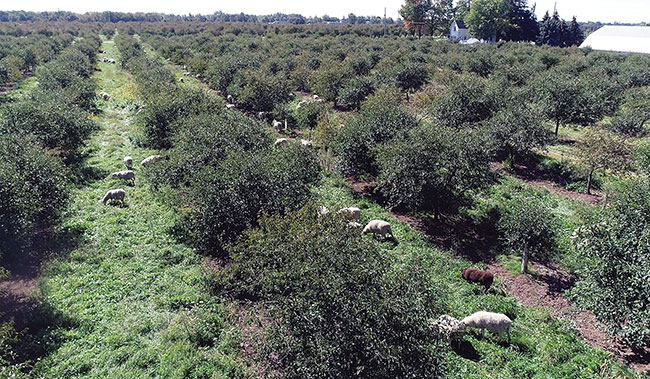
Features
From the Editor: Bringing it together
April 26, 2023 By Alex Barnard
 Management and adaptation are key to successfully incorporating silvopasture into an operation.
Photo courtesy of Jeff Tribe.
Management and adaptation are key to successfully incorporating silvopasture into an operation.
Photo courtesy of Jeff Tribe. Fruit and vegetable production in Canada contains an enormous variety of crops, practices and pests, with few consistent factors across the industry. Soil and water are two of the rare uniting factors for a grand majority of growers. As this is our soil and water management issue, most of the content contained herein discusses these two agricultural equalizers in a variety of ways.
On page 8, Caitlin McCavour, soil specialist with Nova Scotia’s Perennia Food and Agriculture, discusses the potential issues caused by increasingly extreme weather events and shifting precipitation patterns on Atlantic Canada’s soils and water availability at crucial points throughout the growing season. While we can only hope storms like 2022’s Hurricane Fiona are few and far between, it’s never a bad idea to learn ways to mitigate damage to soil and water systems.
The Organic Council of Ontario’s Stephanie Brunet writes about Gillian Flies and Brent Preston of The New Farm (see page 14) and their journey to improve soil health through the regenerative organic practices used on their farm.
Regenerative agriculture has become quite the buzz phrase in recent years, but for Tea Creek’s Jacob Beaton (page 20), it’s part of a legacy dating back to pre-colonial Indigenous farming practices. He’s working as part of an advisory group for B.C.’s Regenerative Agriculture and Agritech Network to benefit Indigenous communities and increase understanding and uptake of regenerative agricultural principles.
And, for those of you who saw the cover and thought, “Why are there sheep in a magazine about produce?”, flip through to page 18, where Jeff Tribe breaks down the mixed agricultural practice of silvopasture. The practice of bringing together livestock, grazing and agroforestry is hardly a new one, having occurred in different incarnations around the world through the years. It fell out of vogue in the 1940s and 50s due to shifting goals and poorly suited management practices but can have environmental and economic benefits for those with the passion to put in the time and effort to figure it out.
I have the good fortune of living near the farm featured in this story, and there is little that brings a smile to my face faster than seeing those sheep grazing in the orchards and woodlots around the property.
Long-time readers will know that Fruit & Vegetable typically publishes an issue in May. Unfortunately, this year we will not, so this is the last you’ll hear directly from us until November. I’ll take this opportunity to wish you the very best for the 2023 growing season. While most of you will have already started the season in some way, with warming temperatures (fingers crossed) comes a large part of the work.
May moisture levels and temperatures be within the desired ranges, and may pests and diseases leave your crops alone. Have a great season!
Print this page